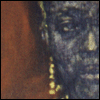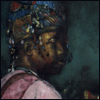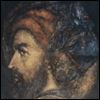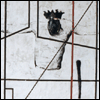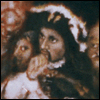Haralampi Oroschakoff (Online Gallery)
GALLERY | BIO | INTRODUCTION | ARTIST’S STATEMENT | SOLO EXHIBITIONS | GROUP EXHIBITIONS
Born in 1955, Sofia (Bulgaria)
Lives and works in Berlin and Théoule sur Mer.
http://www.oroschakoff.com/
The paintings shown in this issue of ARTISTVIEW were to be seen in the solo exhibition “Etre la au bord du Monde: Voyageurs et Orientalistes, 1988 -1999” at the Musee d’Art moderne et contemporain in Geneva/Switzerland in 1999. The were subsequently shown in Saint Petersburg, Russia.
“Settlers on the Edge of the World: Itinerants and Orientalists” aims to reconcile wholeness with fragmentation and are about the lost or neglected narratives rooted in the heritage of East European (particularly Russian) art of the XIX century.
The artist assembles these bits and pieces of dispersed cultural memory with a mixed sense of nostalgia and eagerness to unload this burdening cargo from his shoulders in order to liberate himself (and his generation) from it.
On the level of the visual, the installation is structured in accordance with Oroschakoff’s ambiguous, love-hate relationship with a number of self-erasing referents. The artist’s reading of his own search for “true identity” is focused on two mutually deconstuctive sets of art-works hanged on the walls in such a way that they constitute an altemating sequence. One half of this sequence consists of large dream-like paintings saturated with cultural memorabilia (the sources are all in the storage rooms of the Tretiakov Gallery or the State Russian Museum). These are “interrupted” by minimalist canvases loosely inhabited by various signs and symbols of polarity, detachment and separation which set aside one cultural identity from another. This “cartography” (cartography of identification) resembles photographs of Mars, or those taken from a satellite to depict what we have here, on Earth (Europe, Asia and etc.). It comes close to a rehearsal of an end-game seen through the lens of well tempered, anesthetized, telescopic vision.
“Settlers on the Edges of the World” does not dismiss the validity of identification, especially as an instrument of resistance needed to confront an army of synthesizing clichés, nor does it embrace identity as a “thing-in-itself.”On the one hand, the project is about distancing oneself from all kinds of “corrupting” dichotomies, borders, ethnicity, cultural autonomies and so forth; on the other hand, it questions the moral premises of the globalization of culture under the leadership of economically developed countries. Also, it invites a comparison with a farewell party thrown for old-fashioned, rigidly defined and sharp-edged identity, with its appetite for kitsch and intolerance towards the other.
Oroschakoff’s art has certain affinity with Vladimir Nabokov’s poetry. The following passage from The Gift aptly illustrates this:
How recall
On my way back
My way there?
Victor Tupitsyn
(courtesy Gallery Hohenthal and Bergen, Berlin)
From “Settlers on the Edge of the World: Itinerants and Orientalists”. Musee d’art moderne et contemporain, Geneva. (1997)
For nearly fifteen years, I have been working on “updating” Eastern spirituality and poetics (icons, orthodox crosses, etc.), as well as on issues as diverse as the Russian Revolution, the avant-garde in Russia, or the East-West conflict and the way it plays itself out in art and society. I have always used my own existence as a backdrop to this, the story of my ancestors, the way in which they viewed art from within the constraints of ideology, and in this process I have often felt myself to be a wanderer between two worlds. The historical basis and the specific socio-cultural environment of the contemporary individual demand a universal language of images and forms; for that reason, questions of style have never interested me.
I was born in Sofia in 1955. I am an emigrant and the son of emigrants. My grandfather arrived in Sofia in 1920 after the Russian Revolution and subsequently held several political offices. He was condemned as an enemy of the people in the Stalinist show trials between 1947 and 1949 and later transported to the infamous Beline gulag. Only now have I had a chance to read about the horrors of this camp, in “The Black Book of Communism”. It was known as the camp of “gentle death”: the accused were indiscriminately beaten with cudgels and iron bars and then thrown to hungry pigs as fodder. My Serbian grandmother starved to death in another camp, my uncles were shot or deported, my father was reeducated as a laborer, my Macedonian-Hungarian mother and her family were expropriated. We were scattered to the four winds: Paris, Buenos Aires and Cannes became the new centers of our lives. After my parents fled via Belgrade, where I went to school until 1965, I ended up as a stateless person in the Traiskirchen transit camp. I grew up as a wanderer between Vienna and Cannes, the son of an enemy of the people with an aristocratic family scattered all over Russia and the Balkans, and a new home oriented entirely towards the West, with a language I did not know and whose thought revealed a vision of the world that for me was turned completely on its head.
Torn between romanticizing illusion and absolute questioning, I acquired a new language and began to produce art. My first works dealt primarily with the problem of communication and the general inability to satisfy this need. These were voiceless observations of my new environment, drawn from emigrant families, society as a whole, the art scene, and my own slightly ridiculous celebration of dandyism. In drawings, photos, actions, and above all in installations I built discontinuous spaces as a counterpart to my dream vision of the free and autonomous individual. The scores of the actions stressed the narrow-minded, petty attitudes of people in Western Europe. During a stay on Mount Athos in 1982 I was for the first time after a long period confronted with the Orthodox worldview and with contemporary expressions of Byzantine art and culture. This encounter was like an explosion for me. I became aware of my own history, of my own colors and tones. This collective sound created a space in which I could believe. After having being forced to become an émigré, I finally became a voluntary, political migrant (“Mount Athos”, 1982). This made it possible for meto see the East-West conflict more objectively.
In my work I no longer address the break-down in communication as an inter-personal problem, but rather as a conflict between Eastern and Western Europe. Taking the Russian avant-garde as a basis, the “Patriarchal Cross paintings” became windows, faces, bodies, or planes, whilst always being understood as autonomous painterly surfaces. This represents not merely an intensive interaction with Eastern history and monochrome spirituality, but also an attempt to confront a euro-centric society, rooted in capital, with its Byzantine roots and with Eastern modes of thinking. These various approaches are present in concentrated form in the large installation “Dandolo” 1989/90, where I focus on the way in which Byzantium was destroyed by the West and, at the same time, on Byzantine culture¹s essential indestructibility. This work was shown in Germany at roughly the same time when the Berlin wall came down. The work was seen as a public scandal.
In its petty attitude of decency and narrow-mindedness, Germany could not view my work as an expression of diversity or as an enrichment but, on the contrary, it misread the work as a personal attack. Communication was nipped in the bud. I was forced to accept the fact that the thousand year-long history of the Byzantine Empire had been successfully eliminated from Western historiography, although the Renaissance might perhaps never have occurred without the refugees from Byzantium. One cannot conceive of Moscow, the third Rome, without Byzantium and the Southern Slav empires of the tsars. This mixture of Slav tolerance, Asian cruelty and Oriental poetry is, at the same time, a portrait of this continent, encompassing as it does over 500 peoples and cultures. It is not so much an ethnic problem but rather a temporal discrepancy, comparable to the relationship between Hellenism and modern Greece. I am referring here to the triumph of contemporaneity. The “Russian idea”, instrumentalized in the idea of the “Third Rome” to legitimize Russia’s pre-eminence and its search for identity, determined the political relationship between Russia and Europe in the 19th century. Panslavism took to the idea of re-establishing a “Byzantium after Byzantium” under Russian control. The repeated Turko-Russian wars, the construction of the principality of Bulgaria at the Congress of Berlin, the patronage exercised over the kingdoms of Serbia and Romania ultimately gave rise to the First World War. The Soviet Union realized the “Russian idea” for the first time in territorial terms and, with the help of communism, turned it into an ideology purporting to explain the world. The Soviet Union and the division of the world into East and West, as symbolized by the Berlin Wall, did not become a political fact overnight. In fact, this division had characterized all artistic and intellectual thought of the last two generations.
In 1991 I made the long journey back to Belgrade and Sofia and finally, after two generations, I arrived in Moscow. From that point, a second theoretical strand emerged in my work which became much more process-oriented. This would have been inconceivable without the assistance of many others. The Moscow conceptualists have been friends and colleagues since that time, and Moscow has become my spiritual home. The immense political changes and disruptions of the last decade have made my wandering between the worlds increasingly a socio-cultural affair. I experience each and every day how many souls have been poisoned and I see how communication withers in a nexus of misunderstandings. This has increasingly been the case since 1997, whilst I have been living in the newly reconstructed capital of the world, Berlin. Exclusion of the other is a typical symptom of periods of change. Art as a revolutionary program of progress has proved to be just as dismal a failure as communism was. The division between art and life has become just as much of a simulation as it has become a democratic certainty that unthinkingly defends its own modernity.
The project “Settlers on the Edge of the Earth” (begun in 1995) looks at our atavistic need to defame those living on the other side, those who are unknown, in order to secure our own identity. It is only with great effort that claims to authenticity can be used to conceal the fact that one is clinging to the patterns of a long outmoded avant-garde. There are two aspects to my project. First, there is concrete-abstract form contrasted with figurative-narrative content. The question of content is a political one. All empires create a center that determines culture, morality and customs, declaring these to be universally valid‹at least as long as an empire does not have different concepts imposed upon it by another power stronger than itself. It is the shaky status of these permanently shifting forces, comparable to tectonic plates, that makes them fertile ground for new cultural forms. My map paintings depict the traces of these conquests and erstwhile great powers. Against the unchanging white background and an apparently fragmentary surface, nations, ideologies and religions are placed on an equal footing. They are not signs of cultural memory and identification. I took as my starting point for these paintings Mondrian, Robert Ryman, faded walls, and genre paintings from the Dutch Golden Age.
In contrast to this, the “Wanderers and Orientalists” celebrate individual phenomena and cultural diversity. In the course of the French Revolution and the Napoleonic era, the longings and exotic projections of the modern individual were already feeding into the cliched ideas of the mature cultural bourgeoisie concerning the unknown and mysterious Orient of the Ottoman Empire. In the 20th century, Gustave Courbet’s “The Atelier” and Theodore Gericault’s “The Raft of the Medusa” became monumental motion pictures. What is interesting here are the meticulous academic reconstructions of the costumes, rituals and hierarchies of the peoples and cultures portrayed. As a Romantic individual, I was enthusiastic not only about the opulence and detail of these images, but above all about the unknown desire and freedom to engage in the business of painting as an ornamental realm. At the end of the nineteenth century, the “Wanderers”, Russia’s first independent group of artists, left the Academy in protest to roam the countryside and paint the poor and the marginalised, the “authentic” people. This group, which was the first to formulate its aims in social terms, contained the seeds for many of the revolutions in subsequent Russian art: Diaghilev’s “World of Art”, Kandinsky, Tatlin, Malevich, Yavlensky, Mayakovsky, and Khlebnikov. After that point, everything happened with immense force in an extremely short time, or indeed at the same time.
I composed new paintings from these politico-cultural and historic events, using as many as three sources to create one scene (not a fragment). The new works became panoramas of the twentieth century, encompassing the Ottoman Empire, the first landing on the moon, and the cult figure of John Lennon to the conflict between America and Europe and the phenomena of globalization. It is a contemporary longing for far-away places that finds expression in ill-defined beauty. Whether we are talking here about the abstract or the figurative is only of illustrative significance, for in reality everything becomes an abstract form within an artistic work.
I have again and again run up against the prevailing opinion that painting is no longer capable of representing the world. Painting, unlike photography, remains trapped within its own structure and materiality. The avant-garde called the idea of factual pictorial representation into question. The avant-garde transferred the critique of painting into a form of self-reflexivity, and thus drew a clear demarcation linebetween the work of art and the observer. In historical terms, the process whereby this line became visible reflects a decision with crucial consequences for the autonomous nature of art. Clinging to the dogmatic demands of the avant-garde has become a conservative program that inhibits true progress.
Parallel to this installation I have set up an archive composed of depictions of various types of peoples from the East. For nearly ten years I have been collecting primarily engravings from the last century by Western travelers to the East. It is important here to note the distanced, interested gaze of the civilized, liberal Western European. I dug out these artifacts in archives, libraries and other sites, and drew no distinction between the Oriental-Asian area and the Slav regions. These depictions are mainly in black and white, and are often only portraits or busts. I complete and color these works. This is a work in progress. Eventually I plan to produce a wooden book with legs, which could be looked at but not simply carried away. If photography has forgetting as its major theme, for me, art has always had the role of attacking culture. Or, in the spirit of this archive, of looking not for unity but rather for diversity. That is the last freedom that remains for us.
(A version of this text was given by the artist as a lecture in Mamco, Geneva, on February 1, 1999. Courtesy Gallery Hohenthal und Bergen, Berlin)
1979
Vienna, Konzerthaus: “Ich hab’ getraeumt, ich bin aufgewacht”
1981
Vienna, Museum moderner Kunst: “Kaefig-Freiraum/Projekt”
1982
Munich, Kunstforum/Stadtische Galerie im Lenbachhaus: “Der heilige Berg”
Graz, Kulturzentrum Minoriten, Steirischer Herbst
Munich, Galerie Tanit
1983
Vienna, Sezession
Graz, Galerie Bleich-Rossi
1984
Munich, Galerie Tanit: “Siberia”
Zurich, Galerie Piranesi: “Zauberhaus”
Salzburg, Galeria Academia: “Im Reich der Riesen und Zwerge”
1985
Esslingen, Bahnwarterhaus/Galerie der Stadt Esslingen: “Rila”
1987
Muenchen, Kunstraum: “Ein Ort der Leidenschaft”
1988
Otegem, Deweer Art Gallery: “Ueber die Liebe”
Munich, Kunstraum: “Lampos”
Munich, Galerie Bernd Kluser: “Epikie”
Tuebingen, Galerie Ingrid Dacic: “Bogumili”
Eindhoven, Deweer Art Gallery
Goettingen, Kunsiverein: “Jasenowac”
Kassel, Museum Fridericianum: “Dandolo”
1990
Munich, Staatsgalerie modemer Kunst: “Cambio”
Basel, Galerie Triebold: “Das Wueten nach dem Sturm”
1991
Munich, Kunstraum (with Walter Dahn): Joint Work1987-1990
Tuebingen, Galerie Ingrid Dacic: “An den suessen Ufem Asiens”
Belgrad, Museum of Modern Art: Akademie I, Ktitor
Sofia, Kulturpalast: Werke 1979- 1991
Eliville, ACR Galerie. “Akademie I, Der Stifter”
Florenz, Galerie Carini: “Kelim”
1992
Moskau, International Apartment Art: “Moskau Boogie-Woogie”
Munich, Hohenthal und Bergen: “Polis I”
Frankfurt, Galerie Hirschmann: “Polis 11”
1994
Muenchen, Hohenthal und Bergen: “Doppeltreuz 1984-94”
Basel, Galerie Fabian Walter: “Mud In Your Eyes”
Cologne, Hohenthal und Bergen: “Projekte 1980-94”
Valencia, Galeria Tomas March: “Doppelkreuz”
1995
Munich, Kuenstlerwerkstatt/Kulturreferat: “Kraeftemessen — Instant Archaeology”
Odessa, Galerie Dada: “An den suessen Ufem Asiens”
Berlin, Akademie der Kunste: “Kraeftemessen — Instant Archaeology”
1996
Tuebingen, Galerie Dacic: “Doppelkreuz”
Munich, Hohenthal und Bergen: “Doppelkreuz: Jugoslawien”
Ljubljana, Museum of Modern Art/Moderna Galerija: “InstantArchaeology, Part II”
1997
Cologne, Hohenthal und Bergen: “Erdrandsiedler: Wanderer und Orientalisten”
Berlin, Heinz-Ludecke Bibliothek: “Polis”
Berlin, Hebbel-Theater: “Erdrandsiedler”
Los Angeles, Post: “The Odessa File”
1998
Moskau, State Tretyakov Gallery: “The Odessa File” (Photobiennale 98) Stuttgart, Galerie Tilly Hadereck: Doppelkreuz oder vom Urbild zum Tuerschild”
Nizhny Novgorod, Russland, National Center for Contemporary Art: “The Odessa File”
1999
Genf, Musee d’Art Moderne Contemporain: “Etre la au Bord du Monde: Voyageurs et Orientalistes”
St. Petersburg, The State Russian Museum: “Erdrandsiedler. Wanderer und Orientalisten”
1978
New York, The Kitchen (+Le Plan K): “Naked Lunch”
1982
Bilboo, “Arteder”
1983
Moenchengladbach, Galerie Lohrl
Frankfurt, Theater am Turm: “Das Letzte Band”
Graz, Galerie Bleich-Rossi”
Munich, Galerie Tanit: “Drei Raume”
Vienna, Kuenstlerhaus: Oesterreichische Filmtage
1984
Vienna, Museum des 20.Jahrhunderts: “1984”
Eisenstadt, Landesgalerie im Schlof3 Esterhazy: “Grenzzeichen”
New York, Martina Hamilton Gallery: “Paperworks”
Zurich, Forum (Galerie Tanit)
1985
Graz, Stadtmuseum: “Phase II”
Munich, Galerie Tanit
1986
Santa Cruz de Teneriffa, Galerie Leyendecker: “II Primer Salon Irrealista”
New York, Tony Shafrazi Gallery: “What it is”
1987
Vienna, Museum des 20.Jahrhunderts: “Kunst im Museum seit 1970”
Duesseldorf, CCD Galerie: “Fotoarbeiten”
Munich, Lothringer StralDe: “Aus Muenchner Ateliers”
1988
Chicago, Art Fair, Rosa Esman Gallery
Venedig, Biennale di Venezia, “Aperto 88”
Muenchen, Hypo-Kunsthalle: “Focus 88”
Nizza, Villa Arson: “Sous le soleil exactement”
Munich, A 11 Art Forum: Biennale Venedig, Auswahl
Cannes, Musee de la Castre: “Icanes”
Hamburg, Galerie Muda 2
1989
Dusseldorf, Galerie Conrads: “Lampos”
Munich, Galerie Wassermann: “Zeichnungen”
New York, Turon Travel Inc.: “Jet Lag” (curated by Jan Avgikos and Michael Corris)
Nizza, Villa Arson: “Exactement pas a coté 3”
Darmstadt, Mathildenhohe: Sammlung Thomas
Otegem, Ontmoetingscentrum: Deweer Xth Anniversary Show
Nizza, Villa Arson: “Pas a coté pas n ‘importe ou 4”
Bonn, Kunstverein: “2000 Jahre – Die Gegenwart der Vergangenheit”
Berlin, Galerie Fahnemann
1991
Munich, Galerie Pfefferle: “…Lacht ein Tier ganz nah bei Dir”
Tubingen, Galerie Ingrid Dacic: “Kuenstler fur den Frieden in Jugoslawien”
1992
Frankfurt, Art: “Kuenstlerbuecher”
Vienna, Cajetan Grill “Kunsthandel”
Munich, Hohenthal und Bergen: “Salve”
Kassel, Galerie Vruchtenhagel: “Kunst fuer Atlantis”
Rio de Janeiro, (Weltumweltgipfel): “Columbus” (Artists United for Nature); Munich, Salzburg, Frankfurt, Berlin, Rom, Tokio, Singapur, New York
Kassel, Dokumenta IX: “Atlantis 2000 project”
1993
Venedig, Chiostro San Nicolo/Lido: “Entraxis”
Muenster, Galerie Weber: “Neue Malerei”
Munich, Galerie im Rathaus: “Deutschland im Herbst”
Cologne, Art Cologne: “Art Against Aids”
Tuebingen, Galerie Ingrid Dacic: “10 Jahre”
Munich, Kunstraum: “20 Jahre Kunstraum Muenchen”
1994
Amsterdam, “The Drawing Room”
Cologne, Hohenthal und Bergen: “Punishment & Decoration” (Curator: Michael Corris)
Munich, Stadtische Galerie im Lenbachhaus: “Ansichten”
Eichherg (A), Schloss Aichberg: “Idole”
Sofia, Galerie 36: “Az-Bogove”
Berlin, Galerie Eigen + Art: “Private Mix” (curated by Olaf Nicolai and Frank Eckart)
Cologne, Media Park, 8. Int. Photoszene: “Ost-West”
Genf, Musee d’art moderne et contemporain (mamco): “rudiments d’un musee possible 1”
Prato, Galerie Carini: “Premiere”
1995
Moskau, Institut of Contemporary art: “Private views on the war”
Bahcisaray/Crimea, Castlemuseum: “Dry Water”
New York, Gallery Bravin Post Lee: “Country Code”
Vienna, Kunsthalle: “Glaube, Hoffnung, Liebe, Tod”
1996 Frankfurt, Galerie Tobias Hirschmann: “Rosen Tulpen, Nelken”
Bonn, Kunst- und Ausstellungshalle der Bundesrepublik Deutschland: “natur?”
Odessa, Gesellschaft fur moderne Kunst: “Phantome Opéra”
Cologne, Du Mont Kunsthalle: “Der zerteilte Blick”
Regensburg, Diozesanmuseum: “Kulturzeichen Kreuz” (K)
Salzburg, Rupertinum: Collection Wolfgang Graninger
1997
Los Angeles, Gallery LASCA: “Drawings”
Paris, Galérie de France: Adaud “Tete a tete”
Berlin, Hohenthal und Bergen: “Mystical Correct”
1998
Berlin, Haus am Waldsee: “Die roemische Spur”
Berlin, Hohenthal und Bergen: “Malewitsch und das Schwarze Quadrat”
Almaty (Kasakhstan), Central State Museum: “IV. Internationale”
Frankfurt, Galerie Tobias Hirschmann: “Blick auf die Zeichnung”
Oneonta, New York, Yager Museum, Hartwick College: “Modemism and Post-Modernism: Russian Art of the Ending Millennium”
Gumru (Armenien), Central House of Artists: “Earthquake”
1999
Detmold, DSVKunstkontor: “25 Jahre Edition S”
Berlin, Hohenthal und Bergen: “Drama Lenin – Stalins Tragoedie”
Barcelona, Tecla Saia: “De Coraz(i)on”
Moskau, Orangerie: “Rodina i smert’”

